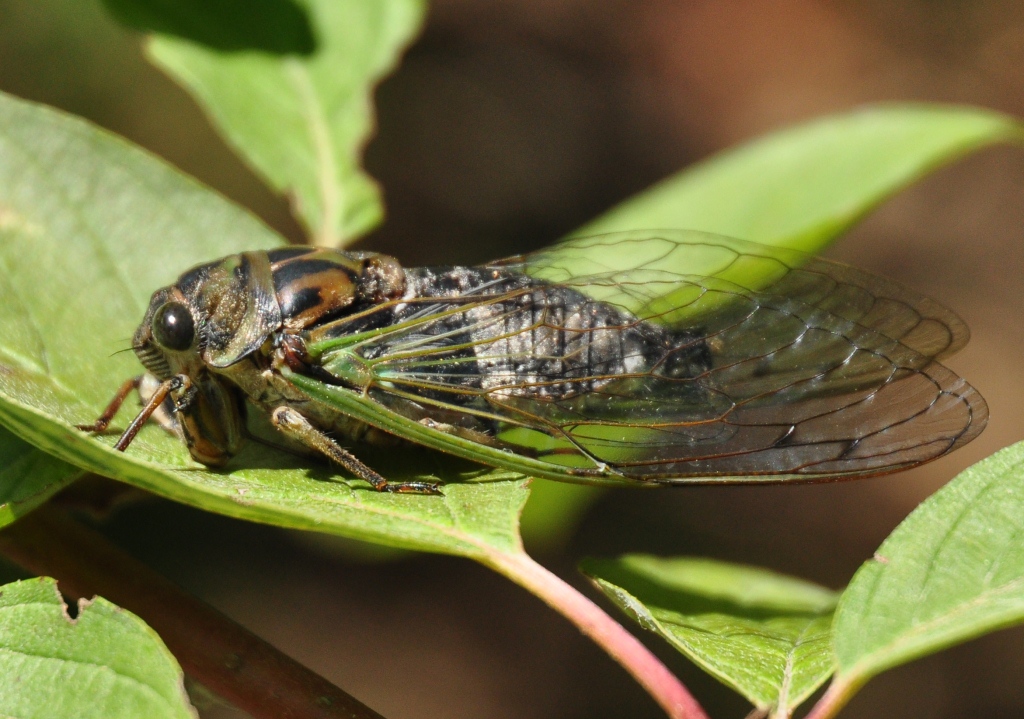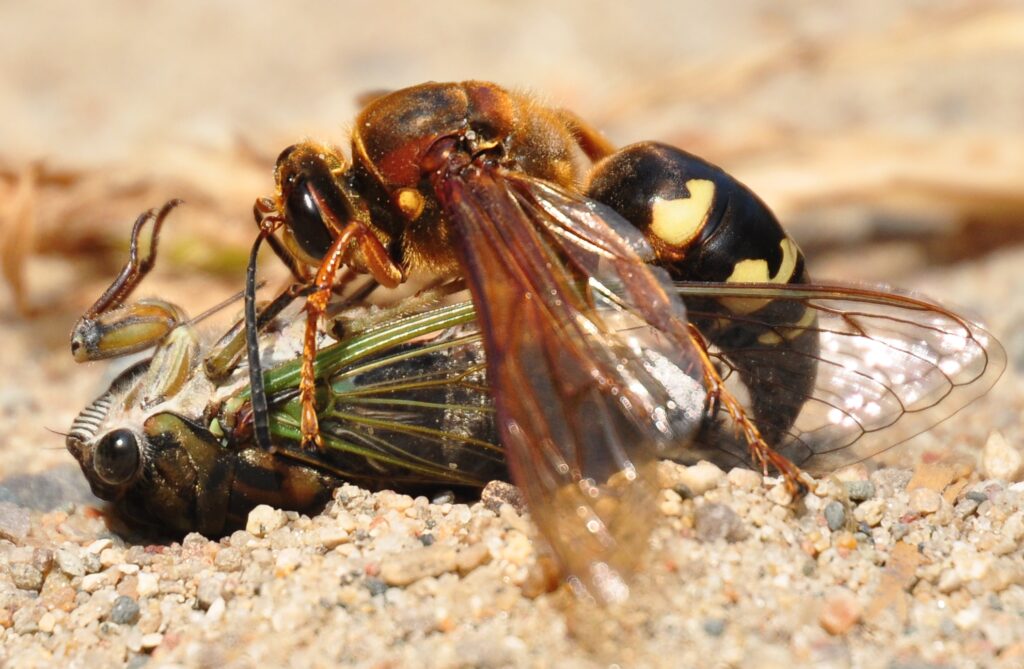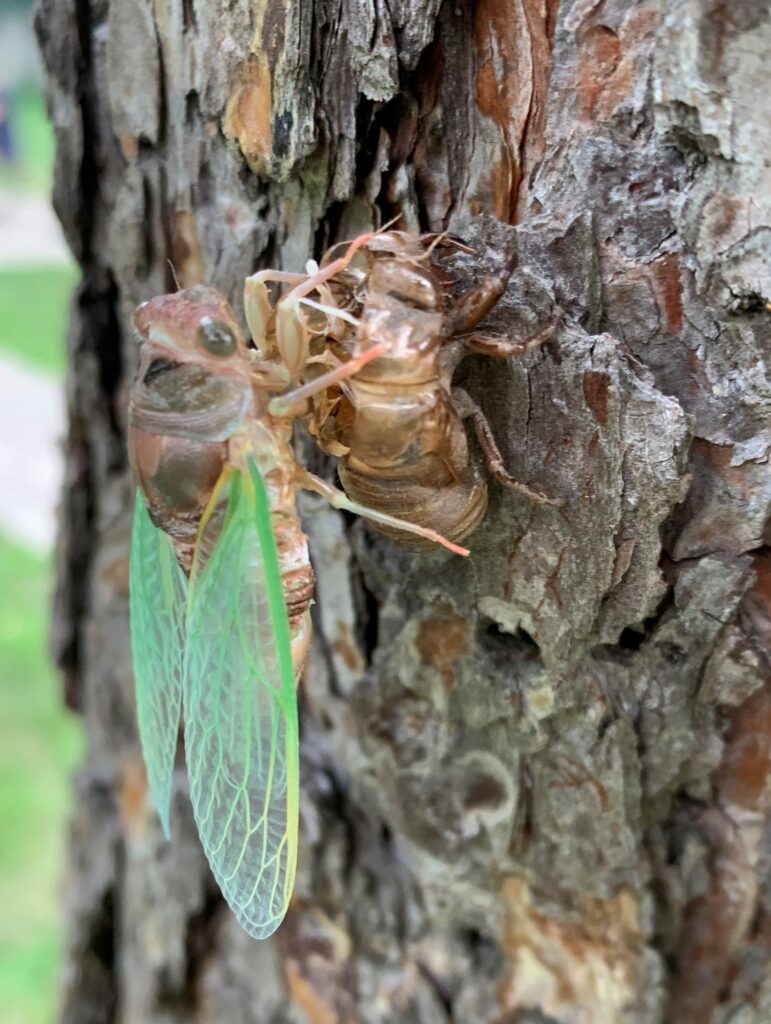Photography courtesy of Lowell Washburn, all rights reserved.
It’s late summer and the signs of the season are emerging. Right on schedule, this year’s crop of annual cicadas are making their appearance, and the distinctive ‘song of the locust’ has begun filling the sultry summer atmosphere. With volumes exceeding 100 decibels, the ear-piercing trill is impossible to miss. Louder than your neighbor’s lawn mower; the cicada’s song is the insect equivalent of a dull power saw chewing through plate steel. For many folks, the cicada provides an audible reminder that summer heat is on borrowed time. For others, the harsh buzzing is just one more item on a growing list of hot weather annoyances.

But not all opinions are so negative. The giant cicada killer wasp is a notable exception. As far as this fearsome looking, six-legged predator is concerned, the cicada’s noisy rattling is simply the sweetest sound on earth. The admiration is far from mutual. For emerging cicadas, the huge wasps represent their worst nightmare.
Although completely harmless to humans, cicada killer wasps are formidable aerial predators. The annual cicada is their one and only prey. It is worth noting that cicada hunting is the sole domain of female wasps who relentlessly search the summer treetops. Once a cicada is located, the wasp delivers a single sting; injecting a potent shot of venom that instantly immobilizes – but does not kill — its victim. The wasp then airlifts her heavy cargo back to her home base tunnel. In spite of the cicada’s weight and cumbersome design, the incoming wasp usually dead centers the tunnel’s entrance with such precision that you barely have time to catch a glimpse before predator and prey disappear underground. The accuracy of the landing becomes even more amazing when considering the cicada’s weight is three times that of the wasp.

Female cicada killers are extremely efficient at what they do, securing and delivering new victims every 12 to 15 minutes. Once the immobilized cicadas are spirited below ground, the horror factor escalates. What began as a sunny afternoon of treetop singing has suddenly become a nightmare of Stephen King proportions. What lies ahead for the sedated cicada isn’t likely to be featured during Kiddies’ Story Time.
Upon reaching her underground lair, the wasp deposits her prey in one of several tiny chambers. Once the cicada has been “checked in”, the female lays a single egg on her victim. Mission accomplished, the wasp seals the chamber entrance and departs. Female wasps supply a single stunned cicada for eggs that will develop into males, but two or three cicadas for future females. Amazingly, the mother knows in advance which gender an egg will become. — Don’t ask how. Nobody knows.

Like a side of beef hanging in the local locker, the paralyzed cicada lies on its back, in the dark, and waits. In two or three days the wasp egg hatches, and immediately begins to devour its protein packed host. Meanwhile, the larvae’s mother is busy constructing new ‘guest chambers’ and continues filling the summer nursery — one stunned cicada at a time. Capturing cicadas is the wasp’s life mission. But her time on earth is brief, and all adult cicada killers will have perished by summer’s end.
Not all cicadas become victims, of course. Those that evade predators will soon deposit their eggs beneath tree bark. Upon hatching, the tiny nymphs fall to the ground and borough into the soil where they employ spear-like beaks to tap tree roots for sap. Three to five years later, maturing nymphs will tunnel back to the surface. Climbing the nearest tree, the nymph splits its plastic-like skin and the familiar anvil headed adult emerges. Within hours, the sound of singing cicadas will fill the summer air. Although the emerging adults are at least three years old, they are called ‘annual cicadas’ because a new crop appears every summer.

The first of this year’s cicada killer eggs are already hatching and underground wasp larvae are voraciously consuming their paralyzed hosts. Once its meal is complete, the larvae will spin a cocoon of sorts and then go dormant; spending the remainder of the summer, fall, and winter in the underground chamber its now deceased mother originally prepared and furnished.
For the majority of their lives, cicadas and cicada killers exist in complete ignorance of the other’s existence. The next generation of both species will not appear until late summer 2025 when, right on cue, the lives of two seemingly unrelated creatures will converge with the perfect synchrony of a finely crafted Swiss watch. Once again, the song of the cicada will fill the late summer atmosphere. Within hours, l egions of cicada killer wasps will simultaneously take to the air, and the annual hunt will begin.

 Tom Cope
Tom Cope Sue Wilkinson
Sue Wilkinson Susan Judkins Josten
Susan Judkins Josten Rudi Roeslein
Rudi Roeslein Elyssa McFarland
Elyssa McFarland Mark Langgin
Mark Langgin Adam Janke
Adam Janke Joe Henry
Joe Henry Kristin Ashenbrenner
Kristin Ashenbrenner Joe Wilkinson
Joe Wilkinson Dr. Tammy Mildenstein
Dr. Tammy Mildenstein Sean McMahon
Sean McMahon